Python怎么构建一个文档扫描器
本篇内容主要讲解“Python怎么构建一个文档扫描器”,感兴趣的朋友不妨来看看。本文介绍的方法操作简单快捷,实用性强。下面就让小编来带大家学习“Python怎么构建一个文档扫描器”吧!
准备好环境
首先您应该熟悉Python的基础知识,还需要了解如何使用NumPy Python库。
打开任何Python IDE,创建两个Python文件。将一个命名为main.py,将另一个命名为transform.py。然后在终端上执行以下命令,安装所需的库。
pip install OpenCV-Python imutils scikit-image NumPy您将使用OpenCV-Python获取图像输入并进行一些图像处理,使用Imutils来调整输入和输出图像的大小,并使用scikit-image对图像施加阈值。NumPy将帮助您处理数组。
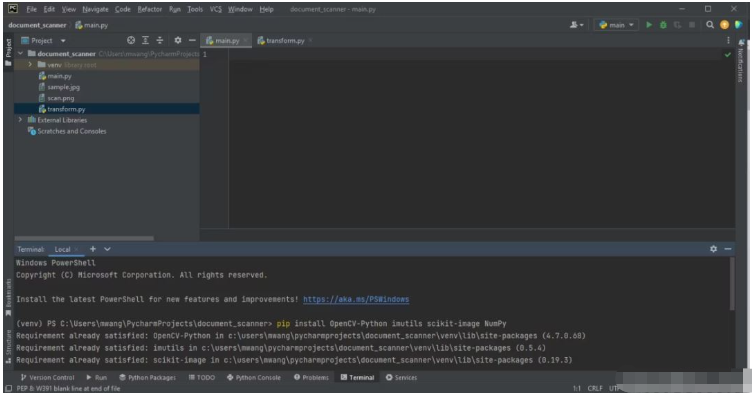
等待安装完成,并等待IDE更新项目骨干内容。骨干内容更新完成后,您就可以开始编程了。完整的源代码可以在GitHub代码库中找到。
导入已安装的库
打开main.py文件,导入所安装的库。这将使您能够在必要时调用和使用它们的函数。
import cv2import imutilsfrom skimage.filters import threshold_localfrom transform import perspective_transform忽略perspective_transform方面抛出的错误。您完成处理transform.py文件的工作后,错误会消失。
获取并调整输入的大小
为想要扫描的文档拍摄一张清晰的图像。确保文档的四个角及其内容都可见。将图像复制到存储程序文件的同一个文件夹中。
将输入图像路径传递给OpenCV。制作原始图像的副本,因为您在透视转换期间需要它。将原始图像的高度除以您想要调整到的高度。这将保持纵横比。最后,输出调整后的图像。
# Passing the image pathoriginal_img = cv2.imread('sample.jpg')copy = original_img.copy()# The resized height in hundredsratio = original_img.shape[0] / 500.0img_resize = imutils.resize(original_img, height=500)# Displaying outputcv2.imshow('Resized image', img_resize)# Waiting for the user to press any keycv2.waitKey(0)上述代码的输出如下:
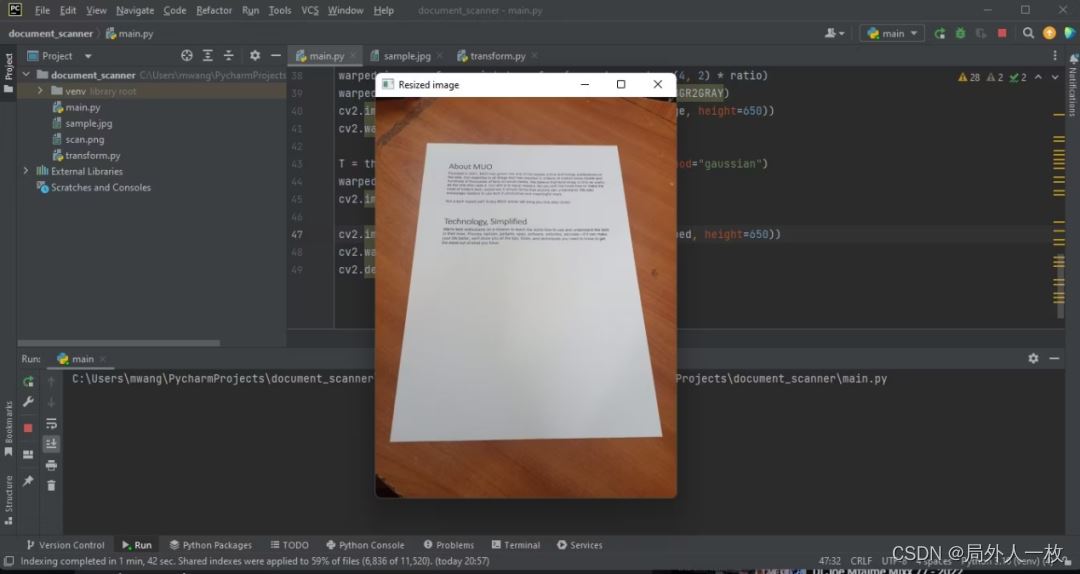
现在您已经将原始图像的高度调整为500像素。
将调整后的图像转换为灰度图像
将调整后的RGB图像转换为灰度图像。大多数图像处理库只处理灰度图像,因为它们更容易处理。
gray_image = cv2.cvtColor(img_resize, cv2.COLOR_BGR2GRAY)cv2.imshow('Grayed Image', gray_image)cv2.waitKey(0)注意原始图像和灰度图像之间的区别。
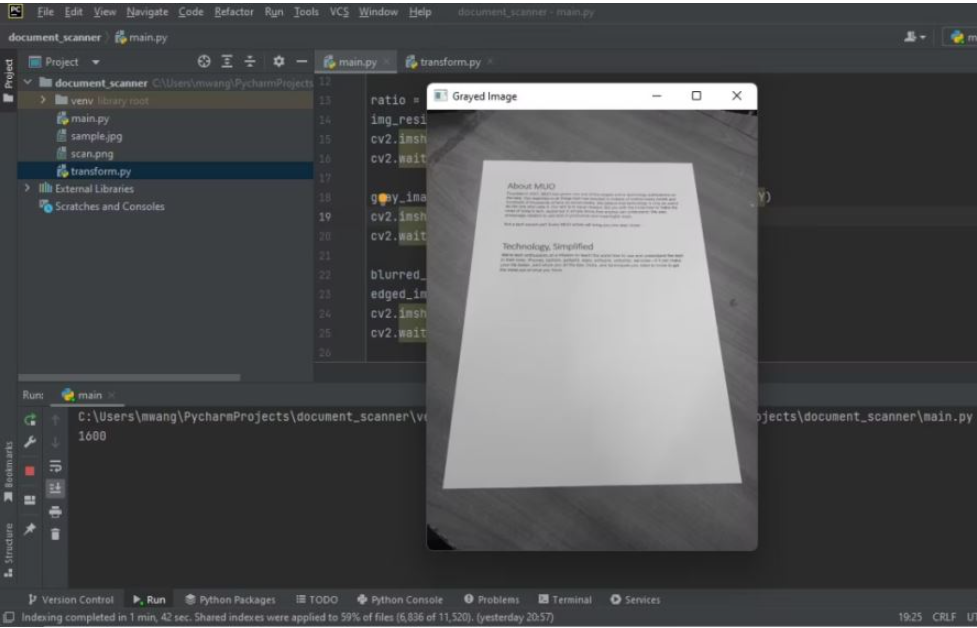
彩色桌变成了黑白桌。
运用边缘检测器
对灰度图像运用高斯模糊滤镜以去除噪声。然后调用OpenCV canny函数来检测图像中存在的边缘。
blurred_image = cv2.GaussianBlur(gray_image, (5, 5), 0)edged_img = cv2.Canny(blurred_image, 75, 200)cv2.imshow('Image edges', edged_img)cv2.waitKey(0)边缘在输出上是可见的。
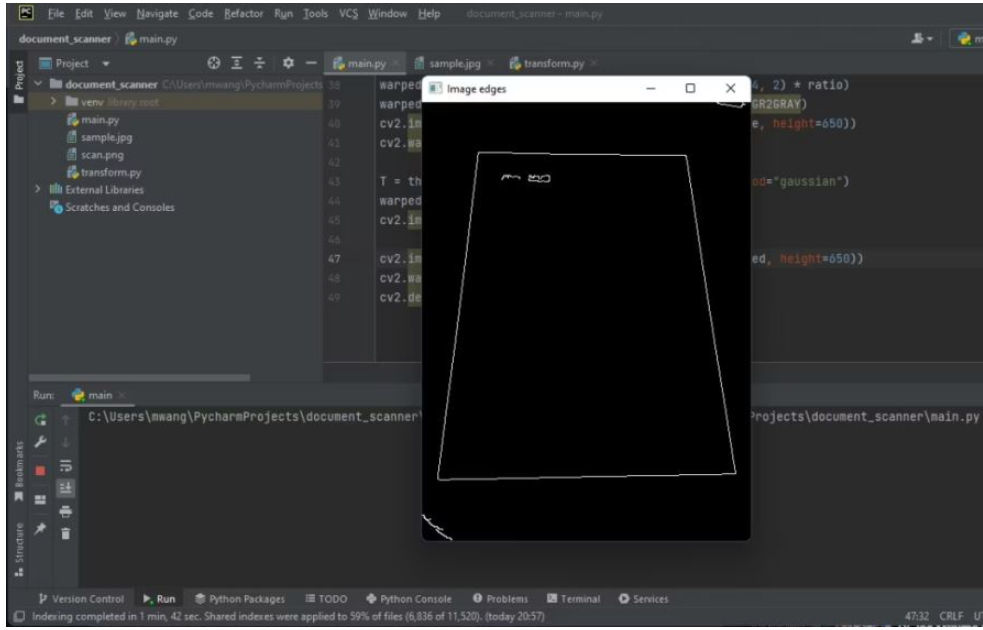
您将处理的边缘是文档的边缘。
寻找最大的轮廓
检测边缘图像中的轮廓。按降序排序,只保留五个最大的轮廓。通过循环排序后的轮廓,近似获取最大的四边轮廓。
cnts, _ = cv2.findContours(edged_img, cv2.RETR_LIST, cv2.CHAIN_APPROX_SIMPLE)cnts = sorted(cnts, key=cv2.contourArea, reverse=True)[:5]for c in cnts: peri = cv2.arcLength(c, True) approx = cv2.approxPolyDP(c, 0.02 * peri, True) if len(approx) == 4: doc = approx break有四个边的轮廓很可能含有文档。
圈出文档轮廓的四个角
圈出检测到的文档轮廓的几个角。这将帮助您确定您的程序是否能够检测图像中的文档。
p = []for d in doc: tuple_point = tuple(d[0]) cv2.circle(img_resize, tuple_point, 3, (0, 0, 255), 4) p.append(tuple_point)cv2.imshow('Circled corner points', img_resize)cv2.waitKey(0)对调整后的RGB图像圈出几个角。
检测到文档之后,现在需要从图像中提取文档。
使用扭曲透视获得所需的图像
扭曲透视(warp perspective)是一种计算机视觉技术,用于转换图像以纠正失真。它将图像转换成不同的平面,让您可以从不同的角度查看图像。
warped_image = perspective_transform(copy, doc.reshape(4, 2) * ratio)warped_image = cv2.cvtColor(warped_image, cv2.COLOR_BGR2GRAY)cv2.imshow("Warped Image", imutils.resize(warped_image, height=650))cv2.waitKey(0)为了获得扭曲后的图像,您需要创建一个简单的模块来执行透视转换。
转换模块
该模块将对文档角的点进行排序。它还会将文档图像转换成不同的平面,并将相机角度更改为俯拍。
打开之前创建的那个transform.py文件,导入OpenCV库和NumPy库。
import numpy as npimport cv2这个模块将含有两个函数。创建一个对文档角点的坐标进行排序的函数。第一个坐标将是左上角的坐标,第二个将是右上角的坐标,第三个将是右下角的坐标,第四个将是左下角的坐标。
def order_points(pts): # initializing the list of coordinates to be ordered rect = np.zeros((4, 2), dtype = "float32") s = pts.sum(axis = 1) # top-left point will have the smallest sum rect[0] = pts[np.argmin(s)] # bottom-right point will have the largest sum rect[2] = pts[np.argmax(s)] '''computing the difference between the points, the top-right point will have the smallest difference, whereas the bottom-left will have the largest difference''' diff = np.diff(pts, axis = 1) rect[1] = pts[np.argmin(diff)] rect[3] = pts[np.argmax(diff)] # returns ordered coordinates return rect创建将计算新图像的角坐标,并获得俯拍的第二个函数。然后,它将计算透视变换矩阵,并返回扭曲的图像。
def perspective_transform(image, pts): # unpack the ordered coordinates individually rect = order_points(pts) (tl, tr, br, bl) = rect '''compute the width of the new image, which will be the maximum distance between bottom-right and bottom-left x-coordinates or the top-right and top-left x-coordinates''' widthA = np.sqrt(((br[0] - bl[0]) ** 2) + ((br[1] - bl[1]) ** 2)) widthB = np.sqrt(((tr[0] - tl[0]) ** 2) + ((tr[1] - tl[1]) ** 2)) maxWidth = max(int(widthA), int(widthB)) '''compute the height of the new image, which will be the maximum distance between the top-left and bottom-left y-coordinates''' heightA = np.sqrt(((tr[0] - br[0]) ** 2) + ((tr[1] - br[1]) ** 2)) heightB = np.sqrt(((tl[0] - bl[0]) ** 2) + ((tl[1] - bl[1]) ** 2)) maxHeight = max(int(heightA), int(heightB)) '''construct the set of destination points to obtain an overhead shot''' dst = np.array([ [0, 0], [maxWidth - 1, 0], [maxWidth - 1, maxHeight - 1], [0, maxHeight - 1]], dtype = "float32") # compute the perspective transform matrix transform_matrix = cv2.getPerspectiveTransform(rect, dst) # Apply the transform matrix warped = cv2.warpPerspective(image, transform_matrix, (maxWidth, maxHeight)) # return the warped image return warped现在您已创建了转换模块。perspective_transform导入方面的错误现在将消失。
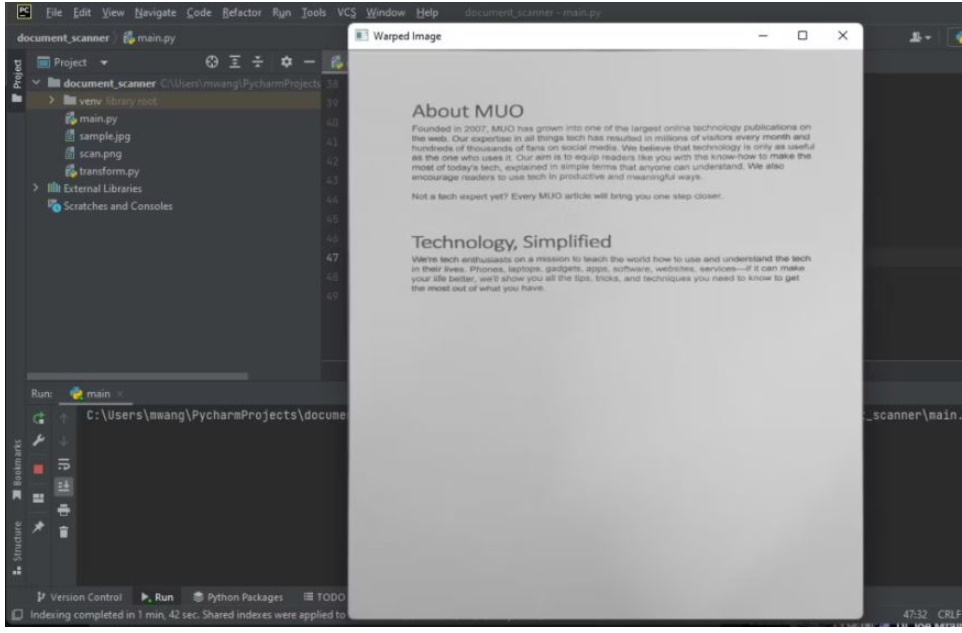
注意,显示的图像有俯拍。
运用自适应阈值,保存扫描输出
在main.py文件中,对扭曲的图像运用高斯阈值。这将给扭曲的图像一个扫描后的外观。将扫描后的图像输出保存到含有程序文件的文件夹中。
T = threshold_local(warped_image, 11, offset=10, method="gaussian")warped = (warped_image > T).astype("uint8") * 255cv2.imwrite('./'+'scan'+'.png',warped)以jpg格式保存扫描件可以保持文档质量。
显示输出
输出扫描后文档的图像:
cv2.imshow("Final Scanned image", imutils.resize(warped, height=650))cv2.waitKey(0)cv2.destroyAllWindows()下图显示了程序的输出,即扫描后文档的俯拍。
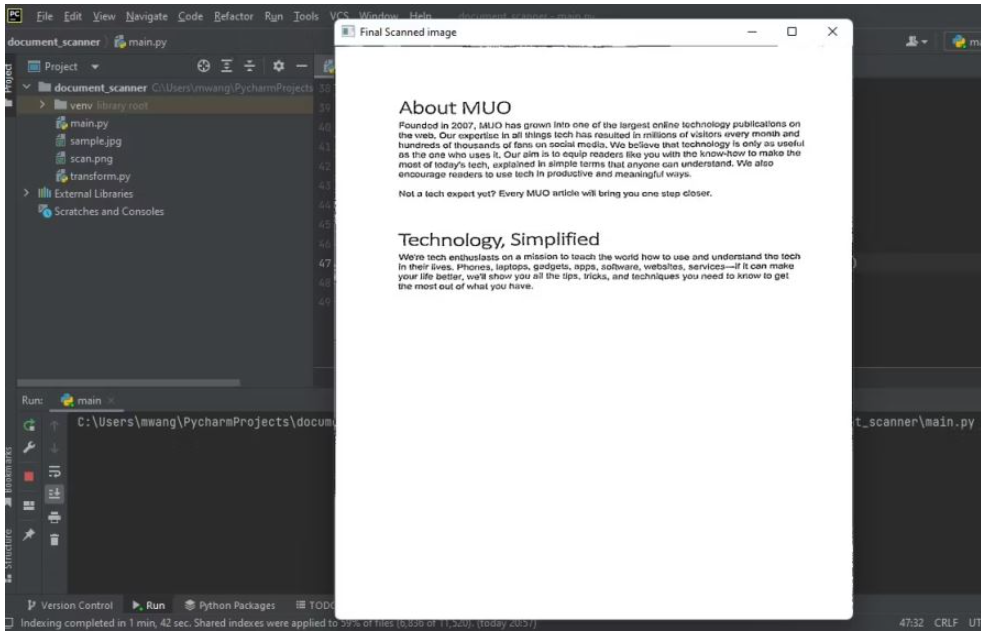
到此,相信大家对“Python怎么构建一个文档扫描器”有了更深的了解,不妨来实际操作一番吧!这里是编程网网站,更多相关内容可以进入相关频道进行查询,关注我们,继续学习!
免责声明:
① 本站未注明“稿件来源”的信息均来自网络整理。其文字、图片和音视频稿件的所属权归原作者所有。本站收集整理出于非商业性的教育和科研之目的,并不意味着本站赞同其观点或证实其内容的真实性。仅作为临时的测试数据,供内部测试之用。本站并未授权任何人以任何方式主动获取本站任何信息。
② 本站未注明“稿件来源”的临时测试数据将在测试完成后最终做删除处理。有问题或投稿请发送至: 邮箱/279061341@qq.com QQ/279061341
















